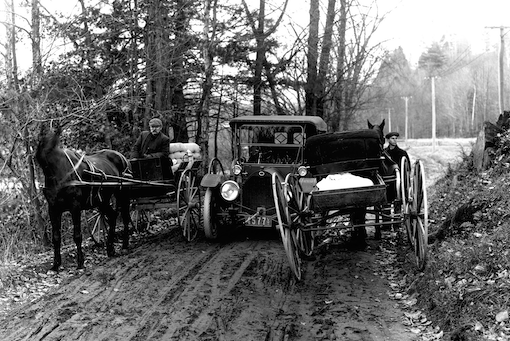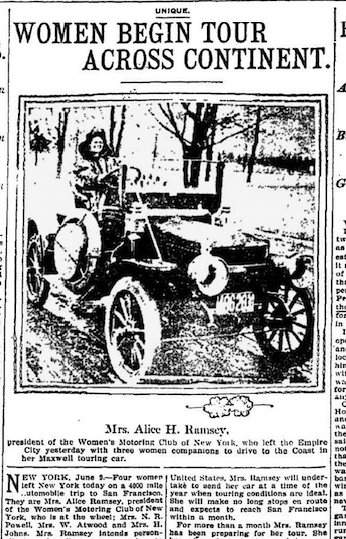ALICE IN AUTOLAND
HACKENSACK, NJ — 1908 — Duke was a rough horse but Alice could handle him. “I’ve got strong arms,” she told her husband. And on a summer afternoon, she set out on horseback. The 19th century itself seemed to ride with her, slow and plodding. Then the 20th century came up from behind.
“There were probably not a half dozen motor vehicles in Hackensack,” Alice Ramsey recalled. But with a honk and a roar, a new Pierce-Arrow “flew by at a 30-mile clip.” Duke bolted. Alice clung to the horse’s neck until he slowed and settled.
That evening, when Alice suggested she get a smaller horse, her husband, a banker and future Congressman, had a more modern idea. “The man from the Maxwell agency thinks you could drive an automobile without any trouble. How would you like to have one of those instead of a horse?”
Alice Ramsey was 22, a newly married mother. But she had “grown up mechanical, something I inherited from my father.” So when Alice hopped in the driver’s seat, she just kept going.
That summer, in her new Maxwell runabout, she drove all over New Jersey, some 6,000 miles. When she finished the Montauk Point Endurance Race, a 150-mile trek across Long Island, a car dealer had a proposition.
“I’ve watched you drive all day,” the Maxwell man said, “and I think you’re the greatest natural woman driver I’ve yet seen. Do you know what I am about to prophesy?”
To show that women, too, could handle an automobile, Maxwell proposed a drive “from Hell Gate on the Atlantic to the Golden Gate on the Pacific.” Was Alice up to it?
The romance of the American road had yet to blossom. Just one person, a doctor from San Francisco, had driven across the country. Six other expeditions had failed. Alice agreed to try, if her husband approved. When his middle-aged sisters, Nettie and Margaret, thought the drive might be fun, John Ramsey agreed. He never “fenced me in,” Alice said.
On June 9, 1909, Alice, Nettie, Margaret, and 19-year-old Hermine Jahns stood in the pouring rain outside the Maxwell auto showroom on Broadway. Beside them was a dark green touring car with a leather roof, add-on luggage and tire racks, and a 20-gallon gas tank. The car also had a rubber bulb “honk honk horn,” a spark throttle, and a crank in front.
Ahead lay 3,800 miles of roads, less than 200 of them paved. The only guidebooks, from the new AAA, used landmarks such as “the yellow house” for navigation. But the Maxwell men had faith in Alice Ramsey. Others were not so sure.
“Where are your guns?” a man in the crowd asked.
“We aren’t carrying any.”
“What about protecting yourselves?”
“We’re not afraid.”
“And don’t you have any pillows?”
“If one of us needs a pillow,” Alice said, “I guess she’ll have to board a train to the next stop. I think we ought to get started.”
Then Alice waved off a man ready to crank up the car and did the job herself. With a sputter, the Maxwell headed up Broadway, crossed the Hudson at Yonkers, and rattled on. By sundown, they were in Poughkeepsie. First Day — 76 miles.
On across America the women “motored.” In their windowless car, they survived muggy heat, torrential rains, and eleven flat tires.
While her companions sat, “well-groomed and dressed in the daintiest of French-heel footgear,“ Alice changed all the tires, cleaned spark plugs, checked the gas by dipping a ruler into the tank, repaired brakes, and did all the driving. When roads were “gluey,” they made just four miles a day. On gravel, they sometimes drove 200 or more.
Outside Chicago, another car careened too close, dented a hubcap, and drove on. “Our first hit-and-run,” Alice noted. Crossing the Mississippi on a wooden plank bridge, “now, at last, we were West.”
But Iowa was “360 miles of gumbo.” Bogged down, backtracking, blistered by the sun, the expedition took 13 days to reach Nebraska. AAA guidebooks did not cover Western states, so Alice navigated by following telephone poles whose wires multiplied when a city was near.
Cheyenne was something out of a Western — cowboys and Indians in the street. Across the Rockies on old trading trails, then south into Salt Lake and on into sagebrush Nevada. One huge ditch took six hours to cross — inching along, jacked above mud, inching further.
Up over the Sierras on snake roads used to service the Transcontinental Railroad, then down, down into California’s golden central valley.
After 59 days on the road, Alice Ramsey and “the girls” drove the Maxwell onto the ferry from Oakland to San Francisco. Then they chugged up Market Street past cheering crowds. The next day’s newspaper read:
“PRETTY WOMEN MOTORISTS ARRIVE AFTER TRIP ACROSS THE CONTINENT.”
Alice Ramsey drove long distance all her life. When her husband died in 1933, she kept cris-crossing America, making 30 coast-to-coast trips, her last at age 89. By the time she died in 1983, the American landscape she loved — the Plains, the mountains, the rugged West — had become “flyover country.” But when she became the first woman elected to the Automobile Hall of Fame, her spirit prevailed.
“It’s been done by men,” she said, “and as long as they have been able to accomplish it, why shouldn’t I?”













